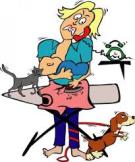|
Theory |
Purpose |
Application to Assignment 3/ Professional Experience |
|
CLEM Model |
Help understand how to learn about a new ICT and how to use it to enhance student learning. |
If there are any new ICTs you need to use it might help your explorations. Hence might be useful as a part of the planning process for Part B. |
|
TPACK framework |
A framework that identifies the knowledge teachers need to teach effectively with technology
Complex interplay of three primary forms of knowledge: Content (CK), Pedagogy (PK), and Technology (TK). |
Helps to identify areas that the pre-service teacher may need help with in regards to ICTs. Namely, the ICT content, ICT pedagogy and the ability to use ICTs.
It can help identify areas that need improvement, gaps in knowledge of how to teach using ICTs and how to use the ICTs. |
|
Backwards design |
Aka UBD. Design unit of work using 3 steps:
Because we can’t know how to teach until we know what we are teaching. |
When designing the Science unit I will be teaching throughout the 3 weeks, I can use the UbD model to effectively plan the assessment and learning experiences according to the curriculum outcomes. |
|
SAMR Model |
Substitution Augmentation Modification Redefinition Model offers a method of seeing how computer technology might impact teaching and learning.
It also shows a progression that adopters of educational technology often follow as they progress through teaching and learning with technology. |
S: iBooks can be used in reading groups A: Read to me function on iBooks is used M: Video recall function on iPad used to record reading R: Use iBook author function to create own text |
|
TIP Model |
Gives teachers a general approach to addressing challenges involved in integrating technology into teaching. |
The TIP Model provides a helpful guide on procedures and issues to address.
As the available ICTs in the Prac classroom are already integrated into teaching/learning at present, this model is unnecessary. |
|
The 5Es |
Works to improve the various domains of learning and higher order thinking skills. Students build on current level of understandings to construct new meaning. |
Whilst this model can be used in a foundation class context, this model will is not appropriate for the content that I will be teaching throughout my professional experience. |
|
WALT & WILF |
WALT: We Are Learning To
The WALT/LO should be shared at the beginning, to introduce the children to the lesson. It is the use of the WILF/SC that will determine the learning outcomes of the children.
WILF: What I’m Looking For
“during this activity, I am going to be looking to see if you are able to….” there is the implication of significant action on the part of the teacher, a) in setting a task that allows this to happen, b) engaged teaching to check on progress thought the task, then c) judgements on achievement, from child and teacher. |
As these are child-friendly ways to express the learning objectives and assessable elements of the lesson, they are very appropriate for my upcoming professional experience.
I will use these at the beginning of each lesson (excepting group rotations and craft activities). |
|
Connectivism |
Learning is distributed within a network, social, technologically enhanced, recognizing and interpreting patterns.
Transfer occurs through connecting to (adding) nodes and growing the network (social/conceptual/biological)
Connectivism regards knowledge as being distributed throughout a network of nodes, which is anything that can be linked. In this case, nodes refer to the knowledge that is attained. Learning can then be considered as developing a map. As the initial map is developed, new pathways will be constructed, allowing the knowledge to travel throughout the network. This in turn allows the learner to easier retrieve knowledge using these pathways. |
This theory, whilst seems effective, is inappropriate for the professional experience I will be attending.
As a Lutheran school, and a prep class, the students are protected from interacting digitally with others. This includes in-school communication and outside.
Additionally, this theory of learning is not totally relevant to the type of learning that these students receive. The majority of their learning is based around social behaviours and the basic processes of literacy and numeracy. As such, there is the majority of teaching is hands-on, repetitive work rather than the more disconnected digital work which is associated with higher levels of understanding. |
|
Bloom’s taxonomy |
Works through a ladder/pyramid of 6 stages designed at increasing students’ higher order thinking skills. |
This framework can be utilised best in this professional experience setting through questioning, rather than more formal activities.
The key is to incorporate/imbed the terminology of verbs into questioning throughout each lesson. |
|
Postman’s 5 things |
|
The concepts of this model are not appropriate for this assessment/professional experience. |
|
Toolbelt theory/TEST framework |
Tool belt theory:
All students, because every human on earth needs some kind of technologies which assist them in their interactions.
We develop tool belts that consist of assistive technology to help us achieve.
TEST Framework:
Task: what needs to be done? Break it into parts. Environment: Where? What constraints? Standard method of task completion? Who is it being done for? Skills: Strengths? Weaknesses? Tools already have? Ability to acquire new skills? Tools: What tool bridges the gap between current abilities and to complete task? If tool not in toolbox, how do we get the tool? If best tool not available, what’s the backup tool? |
Encouraging students to identify technologies that assist them complete their work, practice skills and understand concepts.
Even in Prep students need extra assistance to understand concepts and practice skills, assistive technologies including iPads and computers can be used for this.
This will be useful for students in the Prep class during the introduction of new concepts and skills. |
|
PKM |
PKM gives you a framework to develop a network of people and sources of information that you can draw from on a daily basis. It a process of filtering, creating and discerning so that you spend less time answering email or finding that great presentation you saw, and more time focused on being a better practitioner of your craft. |
During this professional experience, I will develop a PKM that includes: my mentor, other teachers, school staff, other pre-service teachers, other Bach Ed students. |









Recent Comments